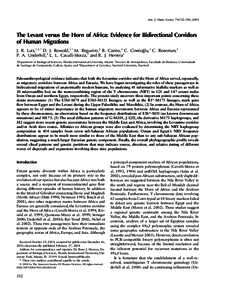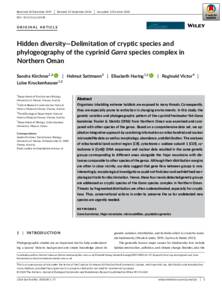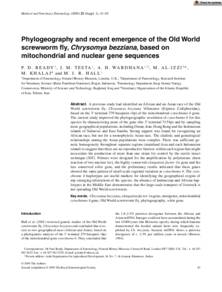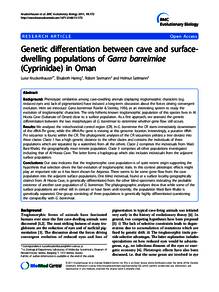Document
The levant versus the horn of Africa : evidence for bidirectional corridors of human migrations.
Identifier
DOI: 10.1086/382286
Source
American Journal of Human Genetics. v. 74, 3, p. 532-544
Contributors
Rowold, D. J., Author
Regueiro, M., Author
Caeiro, B., Author
Cinnioǧlu, C., Abridger
Roseman, C., Author
Underhill, P. A., Author
Cavalli-Sforza, L. L., Author
Herrera, R. J., Author
Country
United States.
City
Chicago
Publisher
University of Chicago Press.
Gregorian
2004-03-01
Language
English
Subject
English abstract
Paleoanthropological evidence indicates that both the Levantine corridor and the Horn of Africa served, repeatedly, as migratory corridors between Africa and Eurasia. We have begun investigating the roles of these passageways in bidirectional migrations of anatomically modern humans, by analyzing 45 informative biallelic markers as well as 10 microsatellite loci on the nonrecombining region of the Y chromosome (NRY) in 121 and 147 extant males from Oman and northern Egypt, respectively. The present study uncovers three important points concerning these demic movements: (1) The E3b1-M78 and E3b3-M123 lineages, as well as the R1*-M173 lineages, mark gene flow between Egypt and the Levant during the Upper Paleolithic and Mesolithic. (2) In contrast, the Horn of Africa appears to be of minor importance in the human migratory movements between Africa and Eurasia represented by these chromosomes, an observation based on the frequency distributions of E3b*-M35 (no known downstream mutations) and M173. (3) The areal diffusion patterns of G-M201, J-12f2, the derivative M173 haplogroups, and M2 suggest more recent genetic associations between the Middle East and Africa, involving the Levantine corridor and/or Arab slave routes. Affinities to African groups were also evaluated by determining the NRY haplogroup composition in 434 samples from seven sub-Saharan African populations. Oman and Egypt's NRY frequency distributions appear to be much more similar to those of the Middle East than to any sub-Saharan African population, suggesting a much larger Eurasian genetic component. Finally, the overall phylogeographic profile reveals several clinal patterns and genetic partitions that may indicate source, direction, and relative timing of different waves of dispersals and expansions involving these nine populations.
ISSN
0002-9297
Category
Journal articles






